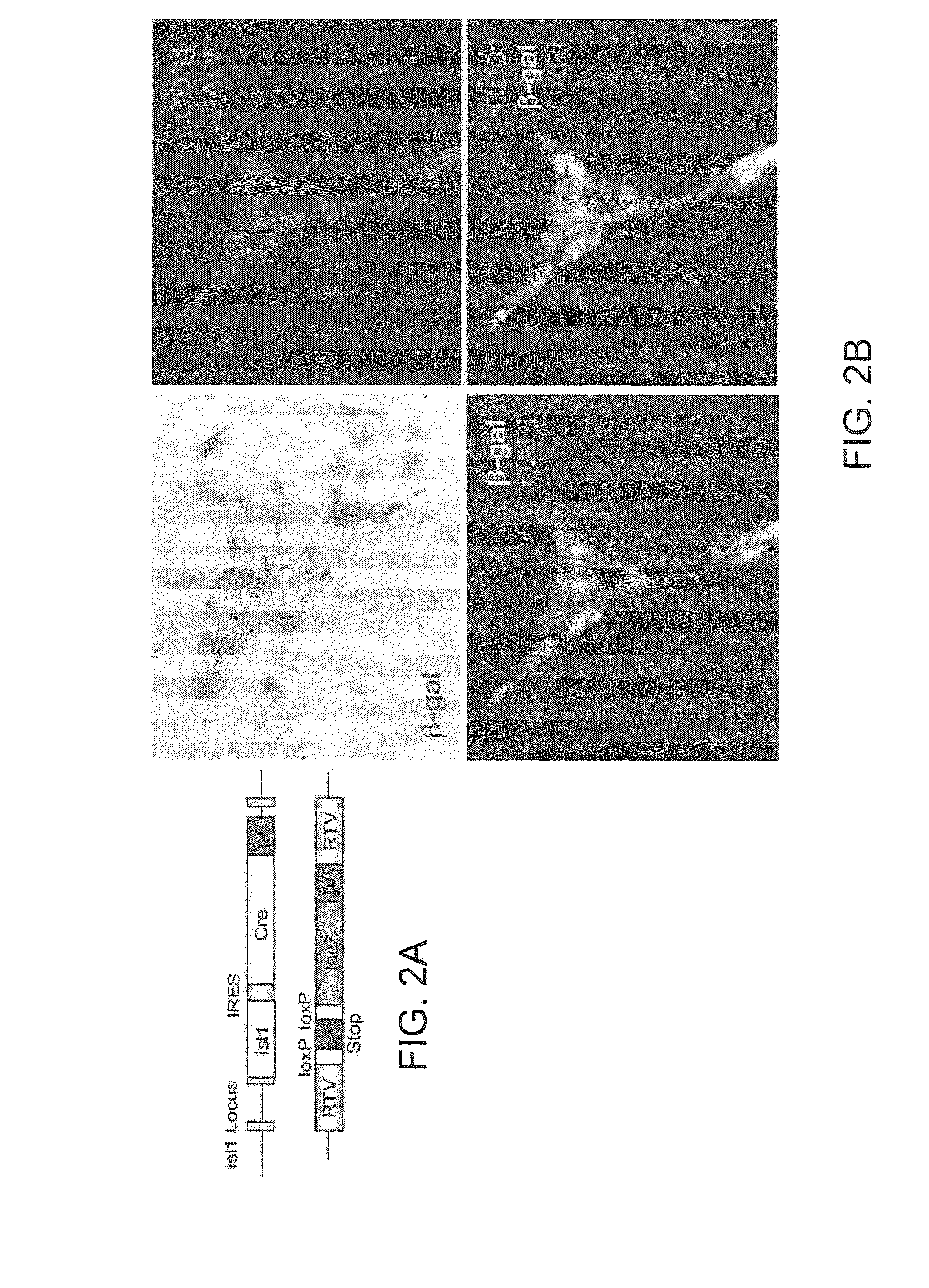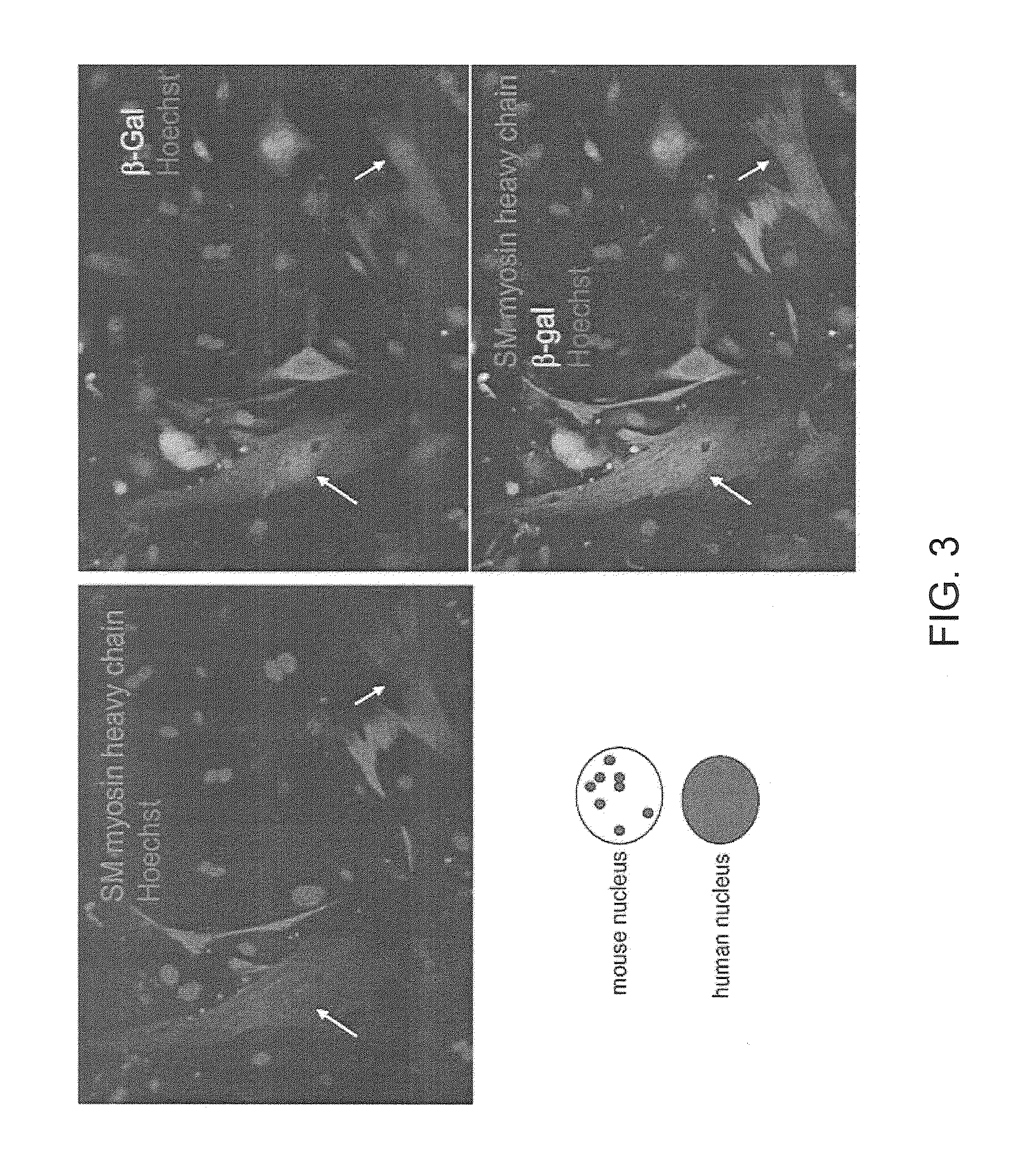Methods of identifying small molecules for renewals, survival and migration of cardiac progenitors
a small molecule and cardiac progenitor technology, applied in the field of high-throughput screening assay, can solve the problem that the spatial requirement for wnt signaling has not been addressed
- Summary
- Abstract
- Description
- Claims
- Application Information
AI Technical Summary
Benefits of technology
Problems solved by technology
Method used
Image
Examples
example 1
Lineage Diversification of Isl1+ Cardiac Progenitor Cells
[0091]Isl1 plays a pivotal role in development of cardiac progenitors of the second heart field, marks postnatal progenitors in postnatal heart, and marks cardiovascular progenitor cells in the early embryo which are pluripotent in vitro. Therefore, understanding factors which regulate Isl1 expression is critical to understanding factors which drive cardiac progenitor proliferation, survival and migration, both in the context of normal development, and for potential application to cell therapies utilizing cardiac progenitors.
[0092]The purification, renewal and differentiation of native cardiac progenitors would form a mechanistic underpinning for unraveling steps for both cardiac lineage formation and regeneration, and their links to forms of congenital and adult cardiac diseases. Until now there has been little evidence for native cardiac precursor cells in the post-natal heart.
[0093]Recently, taking advantage of a developmen...
example 2
Wnt Signaling Function in Self-Renewal of Cardiac Progenitor Cells
[0103]The canonical Wnt cascade has emerged as a critical regulator of stem cells. Stem cells are cells that have the unique ability to self-renew as well as to generate more differentiated progeny. The most primitive stem cell is the embryonic stem cell, which is derived from the inner cell mass of the blastocyst. This cell is pluripotent and can thus generate all tissues of the body. Adult stem cells are normally involved in homeostatic self-renewal processes but can also be rapidly recruited to repair tissues upon injury, their self renewal capacity is limited. The importance of the Wnt cascade was established over the last years for stem cell maintenance and growth in the intestinal, epidermal and hematopoietic system (Reya T. & Clevers H (2005) Wnt signaling in stem cells and cancer. Nature 434, 843-850).
[0104]Wnt genes, of which the human genome harbours almost 20, occur throughout the animal kingdom (Veernan M ...
example 3
β-Catenin Regulates Islet1 Expression in Cardiovascular Progenitors
[0122]Floxed β-catenin mice were obtained from the Max-Planck-Institute of Immunobiology. Isl1-Cre mice were created by a Cre knock-in into the endogenous Isl1 locus, replacing the endogenous Isl1 ATG. Homozygous Boxed β-catenin mice were crossed with Protamine-Cre mice to generate β-catenin+ / −mice, which were then crossed with Isl1-Cre mice to produce doubly heterozygous Isl1-Cre+ / −; β-catenin+ / −mice. These mice were then crossed to β-catenin floxed / floxed homozygous mice to obtain Isl1-Cre+ / −; β-cat- / f mutants for analysis.
[0123]Whole-mount RNA in situ hybridization and histological analyses. Whole-mount RNA in situ hybridization was carried out as previously described. References for specific RNA in situ probes are as follow: Isl1 (EST, GenBank Accession No.: AA198791), Tbx2, Tbx3 and Pitx2 were from the Institute of Neurosciences, University of Padua, Padua, Italy; Wnt11 was from The Department of Molecular and C...
PUM
| Property | Measurement | Unit |
|---|---|---|
| pH | aaaaa | aaaaa |
| pH | aaaaa | aaaaa |
| fluorescence | aaaaa | aaaaa |
Abstract
Description
Claims
Application Information
 Login to View More
Login to View More - R&D
- Intellectual Property
- Life Sciences
- Materials
- Tech Scout
- Unparalleled Data Quality
- Higher Quality Content
- 60% Fewer Hallucinations
Browse by: Latest US Patents, China's latest patents, Technical Efficacy Thesaurus, Application Domain, Technology Topic, Popular Technical Reports.
© 2025 PatSnap. All rights reserved.Legal|Privacy policy|Modern Slavery Act Transparency Statement|Sitemap|About US| Contact US: help@patsnap.com



